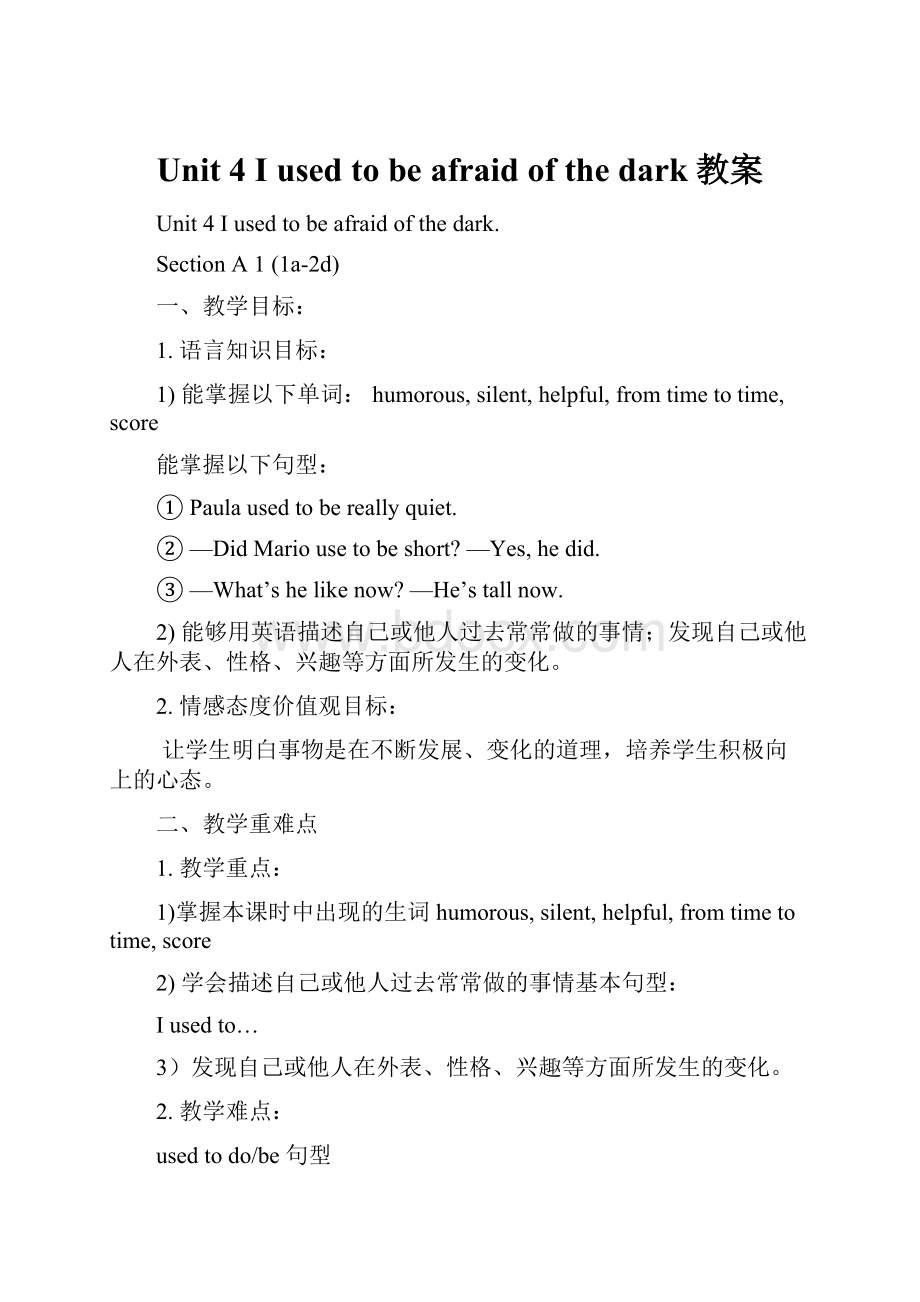Unit 4 I used to be afraid of the dark教案.docx
《Unit 4 I used to be afraid of the dark教案.docx》由会员分享,可在线阅读,更多相关《Unit 4 I used to be afraid of the dark教案.docx(35页珍藏版)》请在冰豆网上搜索。

Unit4Iusedtobeafraidofthedark教案
Unit4Iusedtobeafraidofthedark.
SectionA1(1a-2d)
一、教学目标:
1.语言知识目标:
1)能掌握以下单词:
humorous,silent,helpful,fromtimetotime,score
能掌握以下句型:
①Paulausedtobereallyquiet.
②—DidMariousetobeshort?
—Yes,hedid.
③—What’shelikenow?
—He’stallnow.
2)能够用英语描述自己或他人过去常常做的事情;发现自己或他人在外表、性格、兴趣等方面所发生的变化。
2.情感态度价值观目标:
让学生明白事物是在不断发展、变化的道理,培养学生积极向上的心态。
二、教学重难点
1.教学重点:
1)掌握本课时中出现的生词humorous,silent,helpful,fromtimetotime,score
2)学会描述自己或他人过去常常做的事情基本句型:
Iusedto…
3)发现自己或他人在外表、性格、兴趣等方面所发生的变化。
2.教学难点:
usedtodo/be句型
三、教学过程
Ⅰ.Leadin
1.大屏幕展示RyanCarter的几张照片,引导学生们来描述他的长相特点。
T:
Whatdoeshelooklike?
S1:
Hehaslongcurlyblondehair.
S2:
Hehasaroundface,twobigeyes.He’salittleheavy.
T:
Doeshelikehishair?
Canyouguess?
S1:
No,hedoes.Hewantstocutitshort.
S2:
…
T:
Doyouwanttoknowabouthisstory?
S3:
Sure.We’dloveto.
T:
Ryan’shairissoftandbeautiful.Hismotherthinksit’sreallywonderful.Soshecan’tstandcuttinghisbeautifulhair.ButsomeofRyan’sfriendssaythatRyancan’tplaywiththembecausehelookslikeagirl.
Ⅱ.Listening
1.Lookatthechartin1a,thendiscusswithyourgroupmates.Trytofillinthechartwithwordstodescribepeople.
AppearancePersonality
tall
straighthair
outgoing
funny
2.LetsomeSssaytheiranswers.LetotherSsaddmore.
Appearance:
tall,straighthair,short,ofmediumheight,straight/curlyhair,long/shorthair,heavy,thin,ofmediumbuilt…
Personality:
Outgoing,shy,funny,serious,cute,quiet,kind,brave,friendly,active
3.LearthenewwordswiththeSs:
humorous,silent,helpful,fromtimetotime,score
Ⅲ.Presentation
Showtwodifferentpicturesofsomefamouspeople.Talkabouttheirdifferences.
1.JiangWen:
JiangWenusedtowearglasses,buthedoesn’twearglassesnow.
2.Zhangyishan
Zhangyishanusedtobeshort,butheistallnow.
T:
Explaintheuseof“usedtodo/be…”totheSs.
Ⅳ.Listening
1.T:
Bobhasn’tseensomeofhisfriendsforfouryears.Nowhe’sseeinghisfriends.Whatdidhisfriendsusetolike?
Listenandfillintheblanks.
1)Mariousedtobe______.Heusedtowear_______.
2)Amyusedtobe_____.Sheusedtohave_______hair.
3)Tinausedtohave______and______hair.
2.PlaytherecordingfortheSstolisten.
3.Sslistenandtrytofillintheblankswiththerightwords.
4.Playtherecordingagain.LetSschecktheiranswers.
Ⅴ.Pairwork
1.Lookatthepicturein1aandmakeconversationsinpairs.
2.SsworkinpairstoaskandanswertheappearanceaboutMario,AmyandTina.
3.Letsomepairsaskandanswerinpairs.
e.g.A:
DidMariousetobeshort?
B:
Yes,hedid.Heusedtobereallyshort.
A:
What’shelikenow?
B:
He’stallnow.
Ⅵ.Listening
Workon2a:
T:
Paulahaschangedalotinthepastfewyears.Doyouwanttoknowwhatsheusedtobe?
1.Lookatthewordsin2a.LetsomeSsreadthewordsaloud.MakesurealltheSsknowthemeaningofthewords.
___friendly___outgoing___serious___humorous___silent___active
___brave___quiet___helpful
1)humorousadj.有幽默感的;滑稽有趣的
humor(幽默)+ous→有幽默感的
e.g.Cartoonsarehumorouspictureswithwords.
漫画是附有文字的幽默图片。
2)silentadj.不说话的;沉默的
silentadj.→silencen.沉默
e.g.Peterseemssilenttoday.What’sthematter?
彼特今天似乎很沉默,怎么了?
3)helpfuladj.有帮助的
helpn.(帮助)+ful→helpfuladj.有帮助的
e.g.Hisexplanationwasmoreorlesshelpful.
他的解释多少是有帮助的。
2.PlaytherecordingfortheSstolistenandcheckthewordstheyhear.
3.Playtherecordingagaintochecktheanswers.
Workon2b:
1.LetSsreadthesentencesbelow.ExplainsomemainsentencesfortheSs.Makesuretheyknowwhattodo.
Inthepast
1)Paulausedtobereally______.Shewasalwayssilentinclass.Shewasn’tvery
________.Shewasneverbraveenoughtoaskquestions.
2)Shegotgoodgradein_______.Shewasalsogoodin______.Sheusedtoplaythe______.
Now
1)Nowshe’smoreinterestedin______.Sheplays______almosteveryday.
She’salsoona______team.
2)Shestillplaysthe_____fromtimetotime.
2.PlaytherecordingfortheSstofillintheblankswiththerightwords.
3.Playtherecordingagaintochecktheanswers.
4.Playtherecordingoncemoreandanwerthequestions.
1)Whatclasswerethey?
2)WhatwasPaulaneverbravetodoinclass?
3)WhatsubjectswerePaulagoodat?
4)WhatisPaulainterestedinnow?
Ⅶ.Pairwork
1.TellSstomakeconversationsaboutPaulausingtheinformationin2a.
2.Letsomepairsactouttheirconversationsbeforetheclass.
e.g.A:
Paulausedtobereallyshort?
B:
Iknow.Shewasalwayssilentinclass.
Ⅷ.Role-play
1.ReadtheconversationandLetSsreadaftertheteacher.
2.Readtheconversationagainandcompletetheblanks.
Billhaschangedsomuch!
Heusedtobe____and_____.Hisfacealways_________whenhetalkedtogirls!
Hestudiedhardandgotgood______onhisexams.Heusedtobe____,butnowheis___and_______.
3.AskSstorole-playtheconversationingroups.
IX.Languagepoints
1.Iusedtobeafraidofthedark.
usedtodosth.过去常常做某事
表示过去经常性或习惯性的动作或状态,暗指现在已经不存了,强调过去与现在的对比。
usedto的否定形式有两种:
didn’tuseto或usedn’tto。
usedto用于疑问句时,可借助助动词did,也可以将used提到主语前。
e.g.Theyusedtobegoodfriends.他们过去是好朋友。
(暗示现在不是了)
MrsBrowndidn’tuseto/usedn’ttotravelinsummer.
布朗夫人过去夏天不旅游。
Didyouuseto/Usedyoutoplaytheguitar?
他过去弹吉他吗?
【拓展】几个易混结构的比较:
结构
意义
to的作用
usedtodosth.
过去常常做某事
不定式符号
use...todosth.
用……做……
beusedtodosth.
被用来做……
beusedtodoingsth.
习惯于做某事
介词
use...todosth.用……做……
e.g.Theyusetheknifetocutmeat.他们用刀切肉。
beusedtodosth.被用来做某事
e.g.Thiskindofwoodisusedtomakepaper.这种木头是被用来做纸的。
be/getusedtosth./doingsth.习惯于某事/做某事
e.g.Lucyhasbeenusedto(eating)Chinesefood.Lucy已经习惯(吃)中餐了。
Ithinkyou’llgetusedtotheclimatesoon.
我想不久你就会习惯这种气候的。
根据所给汉语提示完成英语句子。
1)Myuncle__________(以前是个司机),butnowheisanactor.
2)Tom’sfather______________(过去常常看书)afterlunch.
3)Mary________(以前常常骑自行车)towork,butnowshe_______(习惯步行)towork.
4)Thepencil________(被用来书写).
2.Shestillplaysthepianofromtimetotime.
fromtimetotime是一个固定短语,意为“间或;有时”,常在句中作状语。
e.g.Tomgoestovisithisgrandmotherinthecountrysidefromtimetotime.
汤姆时常去看望住在农村的奶奶。
3.Hestudiedhardandgotgoodscoresonhisexams.
scoren.得分;进球
e.g.Hegothighscoresintheexamination.考试中他得了高分。
4.Thispartyissuchagreatidea!
Heusedtobesoshyandquiet.
such与so辨析
such为形容词,意为“这(那)样的;主要修饰名词;
so是副词,意为“这(那)么;如此地”,主要修饰形容词、副词和分词。
e.g.Doyoulikesuchweather?
你喜欢这样的天气吗?
I’msogladtoseeyou.很高兴见到你。
Hecandrawsowell.他画得那么好。
当名词前有many,much,few或little等词修饰时,要用so而不用such。
e.g.Therearesomany/fewpeopleinthehall.大厅有这么多/这么少的人。
Youhavesomuch/littlehomeworktoday.你今天有这么多/这么少的作业。
“such+a/an+形容词+可数名词单数形式”相当于“so+形容词+a/an+可
数名词单数形式”,表示“如此……的一个……”。
e.g.Sheissuchalovelygirl.=Sheissolovelyagirl.她是这个如此可爱的女孩。
选用such或so填空。
1)Themantoldus____funnyastory.
2)Shehas_____abeautifuldress.
3)Howcanyouget____muchmoneytobuythecar?
4)Don’tgooutin______coldweather.
5)Don’teat_____quickly.
X.Exercise:
Iftimeisenough,dosomemoreexercise.
I.根据汉语提示填空,完成句子。
1.Hehasplentyof_________(幽默的)storiestotellus.
2.You’dbetterkeep_______(沉默)aboutwhathappened.
3.Thelazycatisn’tvery________(有用的)incatchingmice.
4.Tomgotthehighest______(得分)intheexam.
II.用usedto将下列汉语句子翻译成英语。
1.他过去常常在卧室抽烟。
2.汤姆过去常常去那儿看电影,但现在他不去了。
XI,Homework
Recitetheconversationin2dafterschool.
SectionA2(3a-3c)
一、教学目标:
1.语言知识目标:
1)学习掌握下列词汇:
background,interview,Asian,dealwith,dare,private,guard,require
2)阅读短文,能按要求获取相关的信息。
3)通过阅读训练来提高学生们的阅读能力。
4)学习运用usedto来表达“过去常常”存在的状态或的发生的动作。
2.情感态度价值观目标:
让学生明白事物是在不断发展、变化的道理,培养学生积极向上的心态。
二、教学重难点
1.教学重点:
1)掌握本部分出现的生词和词组,达到熟练运用的目标。
2)阅读短文,获得相关的信息。
通过阅读练习,来提高阅读能力。
2.教学难点:
1)阅读短文,获得相关的信息的能力。
2)理解并运用所学的词汇及表达方式。
三、教学过程
Ⅰ.Revision
TranslatethesentencesintoEnglish.
1.马里奥过去很矮,他戴着眼镜。
___________________________________
2.他现在长什么样子?
___________________________________
3.保拉以前很安静,她在班上总是很沉默。
___________________________________
4.她总是不够勇敢去问问题。
___________________________________
Ⅱ.Warmingup
展示一张CandyWang的照片,并询问学生们如下问题。
1.Who’sbeautifulandoutgoinggirl?
She’sthefamoussingerCandyWang.
2.Canyouguesswhatshewaslike?
Yeah,sheusedtobeveryshy.
3.Doyouwanttoknowherstory?
Shetookupsingingtodealwithhershyness.
Asshegotbetter,shewasnotshyanymoreandlovedsinginginfrontofcrows.Nowshe’stheAsianpopstar.
Ⅲ.Reading
Workon3a
1.TellSstoreadthearticleandidentifytheparagraphsinwhichthefollowinginformationappears.Numbertheinformation[1-3].
____howCandy’slifehaschanged
____Candy’sadvicetoyoungpeople
____Candy’sbackground
Ssreadthearticlequicklyandtrytonumbertheinformation.
2.方法指导:
先读懂所给的三个句子的意思,明确段落大意。
然后快速阅读短文,争取在较短的时间内,确定每个段落的大意。
3.学生们,按老师指导的方法进行阅读,确定每个段落的大意。
4.最后,教师让部分说出自己的答案,并校对答案。
Ⅳ.CarefulReading
1.Readthefirstpassageagainandanswerthesequestions:
1.HowoldisCandyWang?
2.Whatwasshelike?
3.Whydidshetakeupsinging?
4.What’sshelikenow?
Sstrytoreadandfindtheanswerstothesequestions.
ThenchecktheanswerswiththeSs
2.Readthesecondpassageandfillinthechart.
Goodthings
Badthings
1.Beingabletotravelandmeetnewpeopleallthetime
3.___________________
2._____________
4._________________
ChecktheanswerswiththeSs:
2.Gettonsofattentioneverywhere